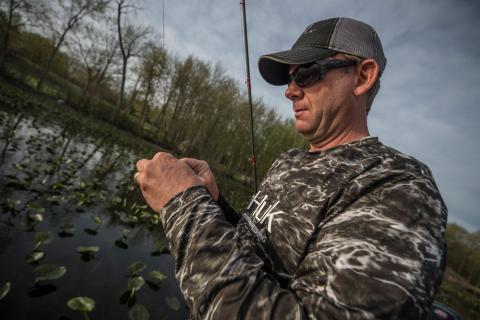Gerald Almy | Originally published in GameKeepers: Farming for Wildlife Magazine. To subscribe, click here.
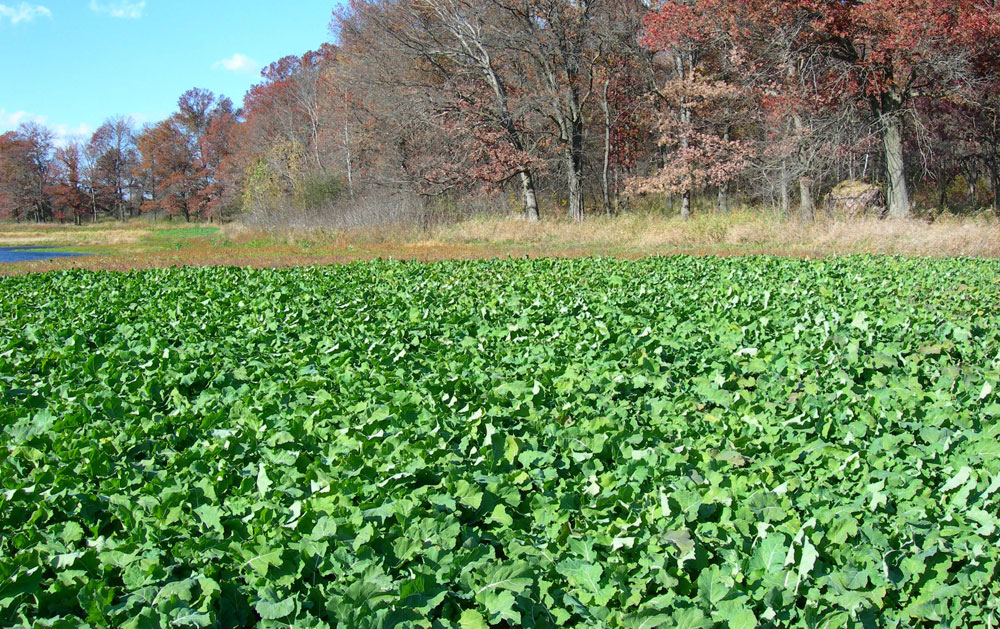
A group of does were feeding on the lush green forage in front of my stand and I knew the odds were good that a buck would soon join them. The acorns in the woods had been depleted, but the Full Draw plot in front of my stand contained both large-leaved brassicas as well as tender cereal grains…a “one-two punch” that the local deer herd found hard to resist. The plants were succulent and packed with protein. Adjoining that smorgasbord was another plot with just pure oats that they could turn to for a change of pace. If the forage itself wasn’t enough attraction for a mature buck, I figured the does in the plot certainly would be.
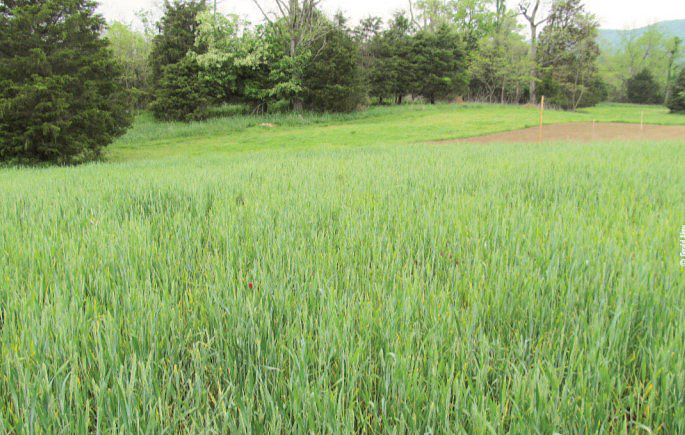
He stepped out as the sun slipped behind the bordering trees and I didn’t hesitate. The huge body, thick neck, sagging belly, raised hair on his back, and heavy mass instantly identified this as a buck worth taking. The .50 caliber muzzleloader belched blue-gray smoke and the big deer dropped on the spot. When I climbed down from the stand I found a tall-tined, mature 9-point that would score in the 140’s—a great buck anywhere, but definitely in my home state of Virginia. That hunt demonstrated the tremendous value of offering a variety of forage to maximize the appeal of your fall food plots. Planting a number of different cultivars, separately or mixed together, ensures that some of them will be at peak productivity and palatability at any given time. A variety also lets you appeal to different deer that might have varied taste preferences.
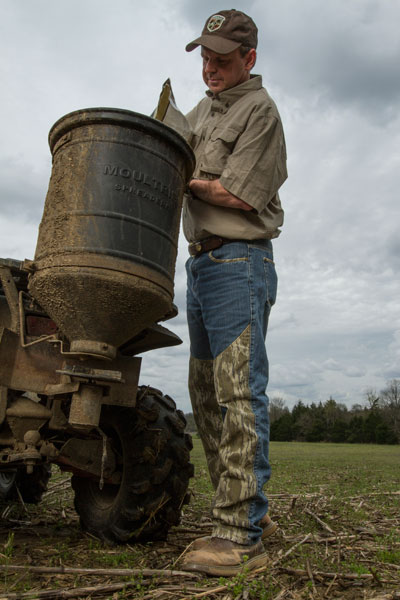
they are both hardy seeds and resilient plants. Brassicas
are typically planted shallower than some cereals, so in
blends that have both you should split the difference, or
simply follow the planting instructions for that blend.
So exactly what plants should you choose to offer maximum attraction to your herd in the fall? Certainly perennial plantings such as clover and alfalfa draw bucks at this time. They should be in any well-rounded management plan. Winter peas are also an option. However, several decades of food-plotting have convinced me that for maximum attraction two types of annual seeds are the best bets - brassicas and cereal grains. These two plant types can be planted separately or mixed together, and occasionally combined with other annuals. Brassicas can include many varieties of rape, kale, turnips, true brassicas and radishes. Cereal grains for the deer manager mean wheat, oats, rye and triticale. Both types of plants (cereals and brassicas) provide strong nutritional value and a taste that deer relish. They can both be eaten down relentlessly and still come back strong, and both can survive deep snow and brutal cold, providing forage right through winter into early spring. Adding to their appeal, they’re easy to grow even for the novice food plotter. In addition, there is no whitetail planting that even comes close to the tremendous tonnage that brassicas can yield.
You can buy single varieties or blends of either brassicas or cereal grain seeds. Biologic offers a wide variety of both single plant and seed combinations for fall that we’ll cover later in this piece. If you just have a few small spots for food plots, blends are best. That way various plants in the blend will be at peak palatability and production at different times, drawing in deer throughout the fall and winter. And if one plant type doesn’t thrive in your growing conditions, chances are the others will. The variety of offerings will also help overcome the smallness of your plots and draw deer to them.
If you have a number of spots for plots or several large areas, my preference is to plant some mixtures and some pure stands of a single plant such as oats or radishes. The wider the buffet choice you offer your local whitetail herd, the more likely every buck and doe in the area will find something they like to feed on. Deer are a lot like people in that regard, with varying taste preferences. Some people love chicken, others steak. Some deer prefer brassicas, others relish oats. Even if you break it down to single species you have many different options with different characteristics. Oats as an example; you have some that are more cold hardy, some that are more attractive to whitetails, some that hold palatability longer, some are more browse tolerant, cold hardy or resistant to drought. This is why most of the time commercial blends are better than single commodity varieties, because companies like BioLogic have done the science and have already discovered the cultivars with the best overall qualities to plant for whitetails.
Now let’s look at the two major groups and how to plant them. As far as timing, in the far north and Canada brassicas are best planted in July into early August and cereals from late July through August. In the mid to northern states the best time to plant fall plots is from July into early September and in southern regions the time frame runs from August into November.

Brassicas
Brassicas are mustard-type plants with large, green leaves that provide up to 40 percent protein and are especially favored by deer after cold temperatures transform their starches into sugars to significantly raise their taste appeal. Once deer eat the leaves and any regrowth, some brassicas like turnips or radishes have large root bulbs or tubers the deer can consume. Those can be particularly important during winter or early spring when other foods are scarce. Depending upon where they’re planted, brassicas can yield huge amounts of food. On a research farm in Quebec, Biologic had Maximum plots producing over 30 tons per acre, with individual plants weighing over 4 lbs each! More realistic and common results would be Deer Radish, as an example yielding about 20,000 pounds of dry leaf forage with another ton or more of root tubers. Kale, rape, true brassicas and turnips can offer 20-40 percent protein levels with over 80% total digestible nutrients.
Is it any wonder these plants are so favored by deer managers? A good pure brassica choice is Biologic’s Maximum, a blend of the best plants developed by deer breeders in New Zealand and tested here in the U.S. This blend was the original brassica planting offered to the food plot market. The line-up of cultivars has changed a bit over the years, when a plant with better characteristics is found it may replace one of the older seeds in the recipe, but this blend has always been “BioLogic’s best brassicas.” For a single species offering, I like Deer Radish. Besides being one of the most attractive plantings available, it also has numerous benefits to the soil. Brassicas are not only great for attracting deer and providing them nourishment, they can also help your plots become more productive for future plantings by adding nutrients and combating two common food plot problems—weed competition and compacted soil.
The large leaves in a fast-growing brassica plot will shade out and kill many troublesome weeds and grasses. They also contain glycosinolate compounds which discourages weeds from taking root around them. In addition, they make vital nutrients such as phosphorous, calcium, and nitrogen more readily available for future plantings on the site by scavenging them from deep in the soil and leaving them at higher, more accessible levels when they die.
Some of these plants, particularly Daikon or Deer Radishes, can also aerate compacted soils that are a common problem in food plots from years of shallow tilling with no deep plowing. Radishes grow a taproot over three feet deep that breaks up and aerates the soil when the root decays, allowing more moisture to penetrate. This enables future plantings to grow deeper and utilize more of the soil’s nutrients. To prepare a plot for planting brassicas, first, kill the vegetation present with glyphosate herbicide. Do a soil test to find out lime and fertilizer needs. Apply those, or add about a ton of lime per acre and a 19-19-19 or similar fertilizer if you haven’t tested. (Testing is preferred!) Till the soil to prepare a suitable seedbed so there are no large clumps and then cultipack it to firm the seedbed.
Broadcast the seed at the rate published in the product’s planting instructions, typically about 4-9 pounds per acre for brassicas. Cultipack again to ensure seed-to-soil contact or barely cover the seeds, about ¼-inch then pack lightly for best results. To add to the appeal of brassicas you can also mix in annual clovers. Several Biologic blends (including Full Draw, Last Bite and Green Patch Plus) contain both brassicas, cereals and clovers, such as berseem, for variety and added taste appeal.
Brassicas will withstand light to moderate browse pressure. If too many deer utilize the plot or they feed on it without leaving enough leaf matter, they can destroy it. Try to plant more or larger plots to spread out the pressure. You can also fence off the plot with electric fences or use a repellent and ribbon system such as P2 Plot Protector while the plants are young. Mixtures that contain both, cereal grains and brassicas help combat this problem by spreading the grazing pressure out to the other plant varieties in the mix. Cereals and certain other plants can bounce back better after heavy feeding pressure. That brings us to the second part of the “one-two punch for fall annual food plots…”

Cereal Grains
Typical cereals planted for deer would include oats, wheat, triticale and rye. When native green forage becomes less available from fall through spring, these crops will attract large numbers of deer and provide valuable nutrition to help them through this difficult period. What’s more, they’ll come back strongly and continue producing more green forage as they are eaten down by deer.
These cultivars can attract whitetails any time from late summer through early spring, but they are particularly valuable both, at the beginning and end of this time frame. Before the starches in brassicas turn to sugars and make them especially attractive, freshly-emerged cereal grains will draw deer to your plots. They are excellent attraction and provide great energy for the rut. They provide prime early-season nutrition and excellent hunting opportunities when planted as soon as August in the north or September in the south. The seeds will germinate in a few days and attract deer quickly taking pressure off your brassicas to grow more green forage and larger tubers.
Oats and wheat will be attractive to deer as soon as they reach a few inches tall, while brassicas will often be more appealing after frosts convert starches in the plants into sugars. That gives a window of up to a month or so where cereal grains will be your go-to plants for nourishing and drawing in deer before the brassicas become sweeter and more appealing and the focus shifts to them. (The exception would be radishes, which often appeal to deer even before frosts). Then later, if you don’t have a large enough area planted and your brassicas get eaten down, the deer may switch their focus back to the cereals from mid-winter into early spring. That is, if they can reach them. In the northernmost tier of states and Canada the crop may have been killed from very cold temperatures or may be covered with deep snow. A bit further south, those crops will continue to produce new growth green forage right into March and April, when perennial clovers and alfalfa come on strong. Prepare the soil just as you did for brassicas then consider these four major cereal grains.
Rye is popular with novices because it is very easy to plant. Simply spread it out on a tilled plot and you’ll have a green field that will attract deer. Disking it in lightly about 1/4 inch is better still and light cultipacking will help it germinate best. Cereal rye has good cold tolerance, but its protein level is modest, at 10-15 percent. It also doesn’t have as much taste appeal to deer as the other grains. You can solve this problem by mixing it with annual clovers, which also adds nitrogen to the soil, and improves the plot’s overall palatability to deer. It can also be mixed with other cereals.
Oats are the second major cereal grain to consider, and in most cases a better choice than rye. These plants originated in Turkey, Iraq and Europe thousands of years ago. They produce forage quickly and have higher protein content than rye, in the 15-25 percent range. As a rule, whitetails prefer the taste of oats over rye. Biologic’s Trophy Oats are excellent for both northern and southern regions with an early-maturing variety and a cold-tolerant species in the mix so they’ll perform well from August through winter. Oats are most attractive when they just emerge to a height of about 6 inches. After that they often get too tall and tough to interest deer. If you don’t have enough deer to keep oats down in the 3- 5 inch range, cut the field back with a mower to this height. New tender growth will emerge and deer will feed heavily on it. Mixing with clover can also help improve the taste appeal of oats while distributing browsing pressure.
Wheat is another good cereal grain for fall plantings, with 12-20 percent protein and a taste deer relish. It too comes back strong after grazing. Both oats and wheat can be planted slightly deeper than rye—1/2-1 inch. Broadcast and disk the seed to that depth, then pack the ground lightly for good seed-to-soil contact and germination. Wheat can survive the coldest temperatures throughout most of the U.S. and Canada. As with oats, if you don’t have enough deer to keep it in the optimum 3-5 inch height, mow it down periodically and it will regrow fresh tasty shoots. Winter Grass Plus, Full Draw, and Outfitter’s Blend all contain wheat mixed with other grains.
Triticale was first developed in laboratories in Sweden and Scotland around 1875, this cereal grain is a hybrid combination of rye and wheat. It was created to blend the yield potential of wheat with the vigor and disease tolerance of rye. It succeeded admirably and has a high yield, good protein content, and excellent digestibility. Triticale works in lower pH soils than wheat and will tolerate cold better. Planting techniques are the same as for rye. Triticale is great for a stand-alone crop, but it also performs well in mixtures such as Biologic’s Outfitters Blend and Winter Grass Plus. Each of these offerings also includes brassicas to provide maximum fall attraction in a single planting.
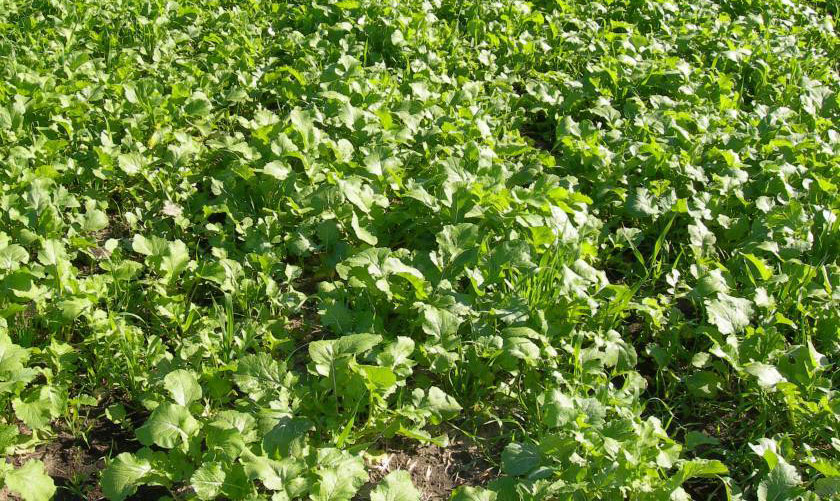
Conclusion
Monitor your plots to determine which ones attract the most deer and when they reach peak production. Experiment with different blends and single-crop plantings to see what parts of your land, soil types and growing conditions each grows best in. With these insights you can then make adjustments in future years to get the ultimate combination of brassicas and grains to see your deer through one of their most difficult and stressful times. In addition, the one-two punch of brassicas and cereal grains will provide fabulous hunting opportunities in the process.















